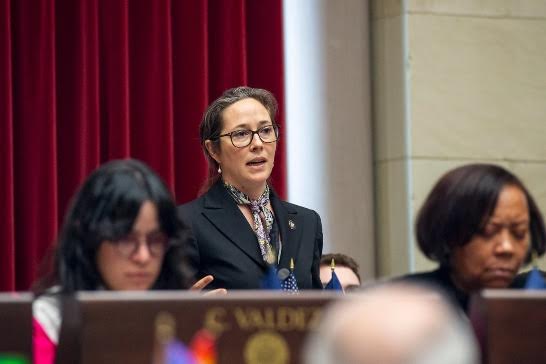Local community paper should cover community events
I’m irritated by the coverage of the No Kings protest by the Port Times Record in the June 19 issue. Why this “community” newspaper continues to give attention to left-leaning causes rankles me. Right there on the front page side-bar were two other stories that merited much greater attention because of their community interest: The PJ mayoral results in a hotly contested election and the nationally ranked rowing teams celebrating the accomplishments of our hard-working teens. Instead, the main focus was on a totally ineffectual protest that accomplished nothing.
Why must the Port Times Record give voice to misguided individuals. For example, the article quotes the protest organizer claiming, “We don’t do dictator parades.” The parade celebrating the founding of the US Army had been planned under the Biden administration for two years.
The irony should not be lost on clear-thinking people that the real dictatorship was the government that required and demanded that we wear masks, stay quarantined, prevented us from worshipping in our churches and synagogues, mandated vaccines, closed businesses, made sure that the elderly died alone, kept us social distant at an arbitrary 6-feet apart and closed schools setting back the education of our children. Who were the real dictators? Where were these antidictatorship protesters then? Yet, the Port Times Record thinks No Kings is front-page news.
Perhaps the Port Times Record should focus on community news and leave its bias to the op-ed page.
Rick Ceo
Port Jefferson Village
Response to Gene Sprouse’s June 12th letter
I am responding ONLY as a longstanding resident of the community, not as a Setuaket Neighborhood House Board member.
I purchased a home on Lake Street in 1976 directly across the Setauket Mill Pond from the Setauket Neighborhood House. Before that, I lived in the B Section of Strathmore for 7 years. A total of 56 years in the community, compared to Mr. Sprouse’s 55 claimed years, is pretty equal local tenure. However, as a person living so close to the SNHfor 49 years, I do have a pretty good sense of the daily activities there.
While living on Lake Street, I used the SNH many times for my children’s birthday parties and for two of my own birthday celebrations.
The Lake Street ladies, led by Eva Glaser, Liz Tyler and Marylu Mills assembled to do the first major redecorating of the house back in 1980. It was the first Three Village Historical Society Candlelight House Tour featuring some homes around the Setauket Mill Pond to raise money to refresh the interior of the Setauket Neighborhood House. I was part of that effort, yet those three ladies deserve all the credit.
I offer the above simply to show my longstanding involvement with the SNH.
I have been a member of the SNH Board for 10+ years now, but this letter is NOT from the board. It is from a local Lake Street resident who happens to be on the board. It is NOT an official SNH Board response, just my thoughts.
The cameras were installed in the SNH as a safety issue, not to monitor or to spy on any groups using the house.
While it IS posted everywhere that NO SMOKING is allowed inside or on the porches, people using the house continue to smoke there. As a member of the Three Village Garden Club, I have planted and maintained the flowering annuals in front of the house for many, many years. I check them twice weekly and pick up the cigarette and cigar butts (along with cups, plates, napkins and other trash) thrown from the porches into the bushes and flowers. Other board members do so as well.
The house is open most days with little or limited supervision. Recently, a group left a kettle on the stove to burn dry, a major fire hazard. People frequently use the house as a bathroom stop. Significant damage has occurred over the years, and it has become worse of late. Items are stolen and damage occurs. We have had groups from other LI communities using the house for fundraisers that are of no benefit to the local community. While the house is available until 11 p.m., some groups illegally stay longer.
For example, two summers ago I heard loud noises from both inside the house and in the parking lot at 11:30 p.m., well beyond closing time. A fight broke out in the parking lot, and I called the Suffolk County Police at 11:45 p.m. An officer arrived at 12:30 a.m. after I made a second call asking the 911 operator why it was taking so long to arrive at the scene of this fight. The operator told me that the police officer did not know where the SNH was even though I explained its location in my original call. Incredible! At 8 a.m. the next morning SNH Board President Tim O’Leary and I were at the house picking up all sorts of garbage left behind by this group. Needless to say, we are both volunteers.
So, yes, Mr. Sprouse, the SHN DOES need cameras for security and safety. I disagree that, “There is little need for this internal surveillance to protect the House….” It is NOT just “our neighbors” who use the house. People from communities 45-50 minutes away rent space there as well. I am not certain they will “value and protect this great community resource.”
As for privacy issues, the house was never meant to be used for secret private political meetings. If privacy is an issue, then such groups should find another place to meet.
No board member is spending time spying on meetings or ogling yoga classes, but when damage occurs (and it certainly has!), we do have a video of the damage done and the responsible party. At one recent meeting, one of the group disabled the camera. Do you support such actions? I do not.
Although groups are told they may NOT tape banners to the walls, just a few weeks ago, a group from outside the Three Village community did so, damaging the paint on a wall that had been painted just months before. We have proof and can assess the responsible group for repairs. Video proof was essential.
Please understand that we have numerous groups who use the house for its intended purpose and deserve credit for their tender care of as Mr. Sprouse asserts, “a wonderful community resource.”
I believe, as a neighbor living near this historic building, that video monitoring is essential to the safety and security of the house. If a group finds that offensive, I am sure they can meet elsewhere or in private homes.
With grateful appreciation to all who use and support the house for its intended purpose from the Constitution and By-Laws –”To promote moral, intellectual, recreational and social welfare of the residents of Setauket, New York and vicinity.”
Julie Robinson Parmegiani
Setauket
The opinions of letter writers are their own. They do not speak for the newspaper.
WRITE TO US … AND KEEP IT LOCAL
We welcome your letters, especially those responding to our local coverage, replying to other letter writers’ comments and speaking mainly to local themes. Letters should be no longer than 400 words and may be edited for length, libel, style, good taste and uncivil language. They will also be published on our website. We do not publish anonymous letters. Please include an address and phone number for confirmation. Email letters to: [email protected] or mail them to TBR News Media, P.O. Box 707, Setauket, NY 11733


















